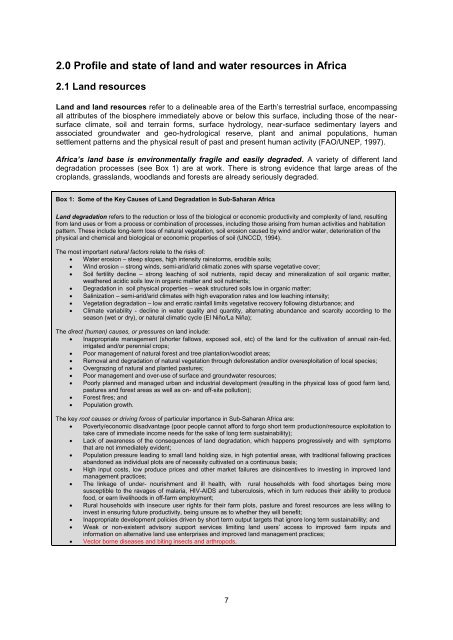The CAADP Pillar I Framework
The CAADP Pillar I Framework
The CAADP Pillar I Framework
- No tags were found...
You also want an ePaper? Increase the reach of your titles
YUMPU automatically turns print PDFs into web optimized ePapers that Google loves.
2.0 Profile and state of land and water resources in Africa2.1 Land resourcesLand and land resources refer to a delineable area of the Earth‘s terrestrial surface, encompassingall attributes of the biosphere immediately above or below this surface, including those of the nearsurfaceclimate, soil and terrain forms, surface hydrology, near-surface sedimentary layers andassociated groundwater and geo-hydrological reserve, plant and animal populations, humansettlement patterns and the physical result of past and present human activity (FAO/UNEP, 1997).Africa’s land base is environmentally fragile and easily degraded. A variety of different landdegradation processes (see Box 1) are at work. <strong>The</strong>re is strong evidence that large areas of thecroplands, grasslands, woodlands and forests are already seriously degraded.Box 1: Some of the Key Causes of Land Degradation in Sub-Saharan AfricaLand degradation refers to the reduction or loss of the biological or economic productivity and complexity of land, resultingfrom land uses or from a process or combination of processes, including those arising from human activities and habitationpattern. <strong>The</strong>se include long-term loss of natural vegetation, soil erosion caused by wind and/or water, deterioration of thephysical and chemical and biological or economic properties of soil (UNCCD, 1994).<strong>The</strong> most important natural factors relate to the risks of: Water erosion – steep slopes, high intensity rainstorms, erodible soils; Wind erosion – strong winds, semi-arid/arid climatic zones with sparse vegetative cover; Soil fertility decline – strong leaching of soil nutrients, rapid decay and mineralization of soil organic matter,weathered acidic soils low in organic matter and soil nutrients; Degradation in soil physical properties – weak structured soils low in organic matter; Salinization – semi-arid/arid climates with high evaporation rates and low leaching intensity; Vegetation degradation – low and erratic rainfall limits vegetative recovery following disturbance; and Climate variability - decline in water quality and quantity, alternating abundance and scarcity according to theseason (wet or dry), or natural climatic cycle (El Niño/La Niña);<strong>The</strong> direct (human) causes, or pressures on land include: Inappropriate management (shorter fallows, exposed soil, etc) of the land for the cultivation of annual rain-fed,irrigated and/or perennial crops; Poor management of natural forest and tree plantation/woodlot areas; Removal and degradation of natural vegetation through deforestation and/or overexploitation of local species; Overgrazing of natural and planted pastures; Poor management and over-use of surface and groundwater resources; Poorly planned and managed urban and industrial development (resulting in the physical loss of good farm land,pastures and forest areas as well as on- and off-site pollution); Forest fires; and Population growth.<strong>The</strong> key root causes or driving forces of particular importance in Sub-Saharan Africa are: Poverty/economic disadvantage (poor people cannot afford to forgo short term production/resource exploitation totake care of immediate income needs for the sake of long term sustainability); Lack of awareness of the consequences of land degradation, which happens progressively and with symptomsthat are not immediately evident; Population pressure leading to small land holding size, in high potential areas, with traditional fallowing practicesabandoned as individual plots are of necessity cultivated on a continuous basis; High input costs, low produce prices and other market failures are disincentives to investing in improved landmanagement practices; <strong>The</strong> linkage of under- nourishment and ill health, with rural households with food shortages being moresusceptible to the ravages of malaria, HIV-AIDS and tuberculosis, which in turn reduces their ability to producefood, or earn livelihoods in off-farm employment; Rural households with insecure user rights for their farm plots, pasture and forest resources are less willing toinvest in ensuring future productivity, being unsure as to whether they will benefit; Inappropriate development policies driven by short term output targets that ignore long term sustainability; and Weak or non-existent advisory support services limiting land users‘ access to improved farm inputs andinformation on alternative land use enterprises and improved land management practices; Vector borne diseases and biting insects and arthropods.7
















